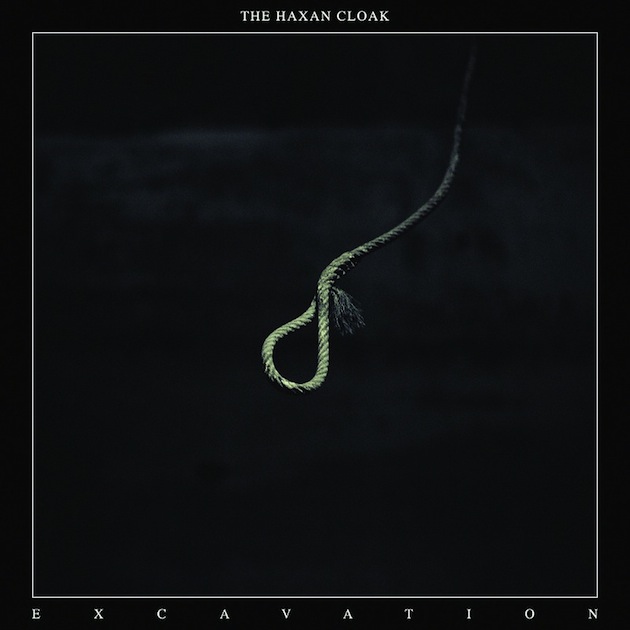Excavation approaches fear and darkness a lot differently than its predecessor. Bobby Krlic’s 2011 selt-tiled debut as The Haxan Cloak was all about externalizing its subjects, using a vast array of acoustic instrumentation–most prominently, cracked, droning strings (Krlic had the resources of the Britten-Pears Foundation at his disposal)–with some electronics to illustrate and outline something tangible and alive and “bound to earth” as Krlic himself put it in a recent interview. The record played like half-soundtrack to, half-sound collage of a festering, claustrophobic haunted house choked with ash and shadow. Excavation goes in the opposite direction, seeking out internal darkness and the core of fear itself. It’s Inland Empire to The Haxan Cloak‘s The Haunting.
Krlic has talked a little about how he approached Excavation as a deconstruction of the elements on his first album: “…really get the magnifying glass in and break them down and go really textural, like Impressionist painting.” Excavation does that. Krlic takes a much more electronic and classic dark ambient route than The Haxan Cloak (without completely abandoning those acoustic elements), relying heavily on subterranean synths, crushed field recordings, and muted techno rhythms, finding aural destinations more abstract and mental, if not metaphysical in nature. And its scope is all the more grand, its landscapes all the more intricate because of it. It puts The Haxan Cloak in the realm of left-field techno lifers like Demdike Stare, Raime, and Vatican Shadow, but where those guys all seem content just to build hellish, alien atmospheres and then float through them (compellingly, for sure), Krlic is nothing but propulsion. It’s the difference between someone who knows tone, and someone who knows how to tell a whole story with it.
Excavation is vivid and physical, each moment meticulously and purposefully crafted. Honestly, the record’s moment to moment geography is jaw dropping. Not just because it’s so alive with subtle, ever-shifting production and textural intricacies (which it is), but because it all works in service of a bigger emotional narrative that’s just as vivid and refined. The album’s grander structural beats work in congruence with its littlest details. Its breadth is enough to encompass clamped, bodily gasps for oxygen as well as visions of gargantuan crumbling mountains in the space of a track and it’s all linked together by the kind of inverted dream logic that turns apocalyptic geological events and deep-seated psychological turmoil into one and the same. Both in size and import. All the while, the record’s sense of emotion is woven in like a double-helix.
The panic-inducing opener, “Consumed” clocks in under two minutes, but it’s one of the most viscerally throttling ambient tracks ever crafted (seriously). The cut opens with some nightmarish voices lurking beneath the blackened liquid surface before a swarm of strings careen upward in pitch to fight-or-flight heights. A world-decimating kick drum slams into it all like an asteroid collision, some bare-ribbed synths rising from below like a colossal primordial evil (the song makes an immediate impression). Krlic is able to create an atmosphere that’s taut enough for every little event to stick out and propel the next. Even on a micro scale. Sure, there’s a ton of intricacy, but it doesn’t just decorate the walls. On “Excavation Part 1” Krlic subtlety tweaks the volume of the kick drum making it clip every so often as if to bump the listener’s heart rate up. When he brings in the ticking hi-hat, it’s quiet enough to seem subtle on the surface, but, really, its surroundings are so tense it’s almost a crescendo.
Then there’s “The Drop.” Over the course of thirteen glorious minutes, Krlic vividly chronicle’s a descent into Lovecraft-ian madness. The track almost works as an epitaph. Tonally and narratively, it stands apart from the rest of the record (at first anyway) as a self-contained piece. It starts by letting a bit of light in with some hopeful, melodic synths, as if we’ve awoken from the nightmare detailed on the previous eight tracks, with just enough teeth to hint everything might not be as it seems. Then it starts to deconstruct itself, letting the melodies linger too long and warping them into new, more malevolent fixtures. Chains start to rattle, strings start to whine, drones start to seep in, while some oil-drum percussion booms off in the distance. The whole track moves in a doomy downward march before it all spirals out of control near the ten-minute mark as some oppressive, icy synths descend like a swirling thunder storm to swallow the track whole, the nightmare consuming everything once again. It’s magnificent and it’s everything The Haxan Cloak does best stretched into an epic.
It’s obvious every inch of Excavation has been given thought. Krlic never does anything as a producer because it’s what is expected. He doesn’t use rhythm because he needs to feed his techno influences or anything. Rhythm is just another tool at Krlic’s disposal he uses with a greater purpose in mind; he uses it to punctuate and reinforce. In fact, based on how different both The Haxan Cloak’s albums are in approach, Excavation is only the album it is genre and sound-wise because that’s what works best for Krlic’s endgoal. It gives Excavation a dexterity in range that’s simply breathtaking–physical, visceral, and gut-wrenching when it wants to be; soft, distant, and foreboding when it wants to be–as well as a sense of freedom and unpredictability that is wholly absent from a lot of modern electronic music. Yet it’s come to define the imprint Excavation is being released on: Tri Angle. Both Balam Acab and Holy Other–and to some degree, Vessel–work with a greater emotional and thematic thread which dictates their sound and with Excavation, The Haxan Cloak readily joins them.


